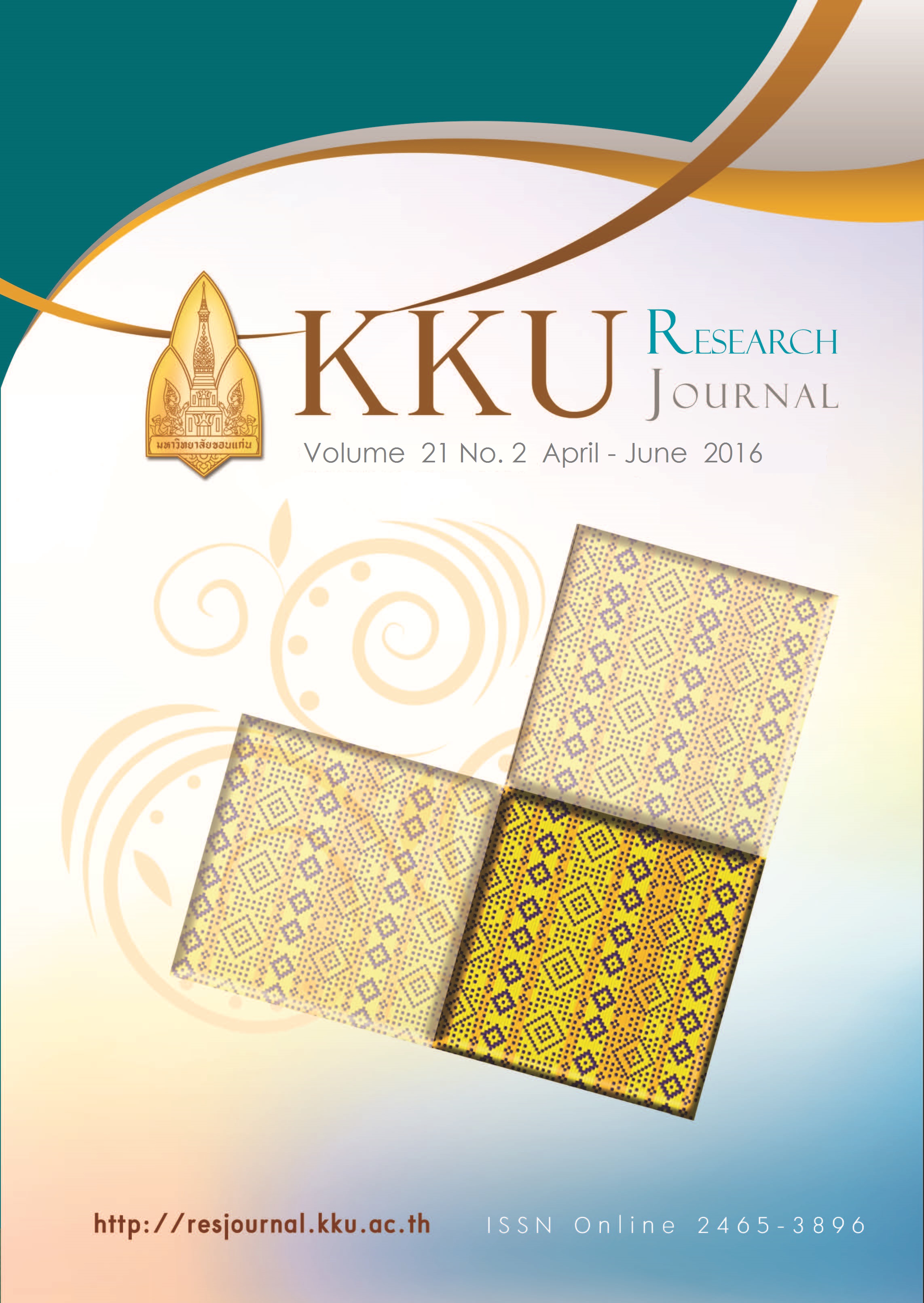Cloning of 1– fructan: fructan fructosyltransferase gene and expression of recombinant 1– fructan: fructan fructosyltransferase in yeast
Main Article Content
Abstract
Fructosyltransferases (FTases) were important enzymes for fructo-oligosaccharides (FOS) synthesis. Recently, FOS was considered as a potential prebiotic in food industry. In particularly, FOS with short chains was used as a new alternative sweetener. The production of recombinant 1- fructan: fructan fructosyltransferase (1- FFT) in yeast
system was conducted in this research. The 1- fructan: fructan fructosyltransferase gene (1- fft) cloned from 105 days old tuber of Kaentawan (Helianthus tuberosus L.) was sub cloned to expression vector, pPICZαB by adding PstI and SacII sites. The cloned gene was successfully transformed to yeast Pichia pastoris X-33 by lithium chloride transformation method. The yeast transformant; P. pastoris X- 33 PF1 showed the ability to produce recombinant 1- FFT. The enzyme activity at 3.57 and 3.33 unit/L was determined in cell and culture medium, respectively. It was also found that FOS was synthesized when recombinant 1- FFT was incubated with 1- kestose and synthesized FOS as substrates. The synthesis of FOS was not detected when sucrose was used as substrate of recombinant 1- FFT.
Article Details
References
[2] Judprasong K, Tanjor S, Puwastien P, Sungpuang P, Investigation of Thai plants for potential sources of inulin-type fructans. J Food Comp and Anal. 2011; 24: 642-649.
[3] Koops AJ, Jonker HH, Purification and characterization of the enzymes of fructan biosynthesis and Helianthus tuberosus Colombia I. Fructan: fructan fructosyltransferase. J Exp Bot. 1994; 45: 1623-1631.
[4] Koops AJ, Jonker HH, Purification and characterization of the enzymes of fructan biosynthesis and Helianthus tuberosus Colombia II. Purification of sucrose: sucrose 1- fructosyltransferase and reconstitution of fructan synthesis
in vitro with purified sucrose: sucrose 1-fructosyltransferase and fructan: fructan 1- fructosyltransferase. Plant Physiol. 1996; 110: 1167-1175..
[5] Lüscher M, Frehner M, Nosberger, J, Purification and characterization of fructan: fructan fructosyl transferase from Jerusalem artichoke (Helianthus tuberosus L.). New Phytol. 1993; 123: 717-724.
[6] Lüscher M, Erdin C, Sprenger N, Hochstrasser U, Boller T, Wiemken A , I n u l i n s y n t h e s i s b y a combination of purified fructosyltransferases from tubers of Helianthus tuberosus. FEBS. 1996; 385: 39-42.
[7] Lüscher M, Hochstrasser U, Vogel G, Aeschbacher R, Galati V, Nelson CJ, Boller T, Wiemken A, Cloning and functional analysis of sucrose: sucrose 1- fructosyltransferase from tall fescue. Plant Physiol. 2000; 124: 1217-1227.
[8] Pan W, Sunayama Y, Nagata Y, Taniguchi M, Takano M, Inoue E, Tamagake H, Anzai H, Cloning of a cDNA encoding the sucrose: sucrose 1- fructosyltransferase (1- SST) from yacon and its expression in transgenic rice. Biotechnol&Biotechnol. 2009; 23(4): 1479-1484.
[9] Praznik W, Beck RHF, Spies Th, Isolation and characterization of sucrose:sucrose 1 F - b - D - fructosyltransferase from tubers of Helianthus tuberosus L. Agri. Biol. Chem. 1990; 54(9): 2429-2431.
[10] Robertfroid MB, Gibson GR, Delzenne N, The biochemistry of oligofructose, a nondigestible fiber: an approach to caloric value. Nutr Rev. 1993; 51: 137-146.
[11] Steinb ü c h e l A , R h e e S K , “Polysaccharides and polyamides in the food industry. Properties, production, and patents.” eds. F r a n c k A , L e e n h e e r L D , Wiley-VCH Verlag GmbH&Co, Weinheim. 2005.
[12] Tanjor S, Judprasong K, Chaito C, Jogloy S, Inulin and fructooligosaccharides in different varieties of Jerusalem artichoke (Helianthus tuberosus L.). KKU Res. J. 2012; 17(11): 25-34.
[13] Ueno K, Ishiguro Y, Yoshida M, Onodera S, Shiomi N, Cloning and functional characterization of a fructan 1 exohydrolase (1-FEH) in edible burdock (Arctium lappa L.). Chemistry Central J. 2011: 5: 16.
[14] van der Meer IM, Koops AJ, Hakkert C, van Tunen AJ, Cloning of the fructan biosynthesis pathway
of Jerusalem artichoke. The Plant J. 1998; 15(4): 489-500.
[15] Van den Ende W, Clerens S, Vergauwen R, Boogaerts D, Le Roy K, Arckens L, Van Laere A, Cloning and functional analysis of a high DP fructan:fructan 1-fructosyl transferase from Echinops ritro (Asteraceae): comparison of the native and recombinant enzymes. J Exp Bot. 2006; 57(4): 775-789.
[16] Wu s, Letchworth GJ, High efficiency transformation by electroporation of Pichia pastoris pretreated with lithium acetate and dithiothreitol. Drug Dicovery and Genome Tech. 2004; 36(1): 152-154.
[17] Vijn I, Smeekens S, Fructan: More than a reserve carbohydrate. Plant Physiol. 1999; 120: 351-359.


